Owner's Opinions
![]() Owner's Opinions
Owner's Opinions
![]() Page
One
Page
One ![]() Page Two
Page Two ![]() Page Three
Page Three ![]() Page Four
Page Four ![]() Page Five
Page Five
![]() Page Six
Page Six ![]() Page Seven
Page Seven ![]() Page Eight
Page Eight ![]() Page Nine
Page Nine ![]() Page Ten
Page Ten
![]() Page Eleven
Page Eleven
![]() Home
Home
 Little Kimmy La Flamme, at 2 years old, getting his 1st lesson of "tough love" ", with his A.I.Dog pup 'Juno' - A.I.D.stud book R.# 0025, one of the first foundation dogs in the A.I.Dog stud book |
 1967 - Kim's sister Laura La Flamme with A.I.Dog pup, Willy - stud book R.# 0247 |
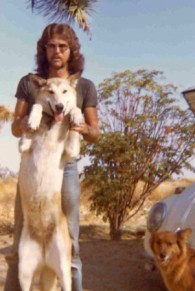 Kim La Flamme with a wolf and A.I.Dog, "Shy Dog" # 0977, on right Kim has done a lot of research on wolves from the 60's when they first started crossing wolves with dogs to create a trainable movie wolf in Acton and Pearblossom Ca. In his opinion, wolves were never used to originally create the old Indian dogs and he would and never will use a wolf to cross into the A.I.Dog breeding program, or anything that didn't have at least a large % of pure Indian dog blood in them for that matter with Indian dog. |
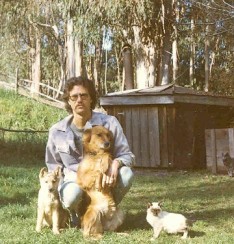 1973 - Kim La Flamme A.I.Dog "Dusty Roads" R.# 1002, and her pup Dawning Moon; G.G.G.G.Grandmother of our dogs now in the breeding program |
![]()
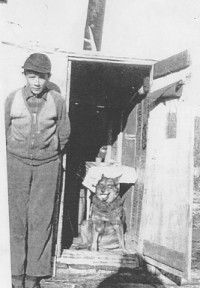 An example of some American Indian Dogs, called 'Camp Dogs', that were found in the 1930's on and around reservations in the northeastern U.S. *camp dog pictures courtesy of Laura Gould |
I have worked to keep the A.I.Dog out of large dog registries from the beginning. I chose to not have the A.I.Dog subjected to the health issues, inbreeding and over population that has taken place because of groups like the AKC as well as other large registry groups, that take away the control from the individual breed clubs. As a matter of fact, one of these former breeders attempted to overtake the breed club in order to force our breed to become a member of the AKC. It is my opinion that the A.I.Dog is not a typical breed and does not belong in these types of modern day registries. We have even incorporated into the Code of Ethics that the breed will never be associated with such a registry.
This breed is very healthy because of the strict control that has been instituted from the beginning of the breeding program. Over the past 40 years, I have interviewed hundreds of Elders who remember the original dogs and the breeding process of the old ways. It is because of these interviews and research that I have come to understand that each Nation had particular individuals with extensive knowledge of the genetic makeup which was passed on to them by their Elders. This knowledge was never questioned as it was very natural and logical and kept the variables (different qualities and/or types within the same working breed) of hunting, pulling, herding, tracking, retrieving, nurturing and other traits that were dependent on what each individual Nation needed.
The Plains Indians had a need for all of these qualities as they traded with all the other Nations from the Four Directions, thus creating a very eclectic and symbiotic, all around working dog which included the Common Indian Dog, the Hare Indian Dog, the Northern Village, Southwest, Tahltan, Southeast and Plains dogs that they, in turn, traded back again. This method of breeding and trading continued for thousands of years creating basically the same breed with those variables from the Four Directions.
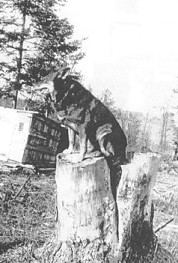 Another example of an American Indian Dogs, called 'Camp Dogs' at the time |
Genetic knowledge is paramount in maintaining the makeup of this breed of dog and is not open for question nor debate by individuals without this knowledge. To see an example of uninformed and uneducated individuals with personal agendas, you are invited to compare the 'statements' of the four exbreeders on their warning site to the "Owners Opinions", "Testimonials" and "Happy Owners" of over 400 owners on the indiandogs.com, iidoba.org, and on true registered A.I.Dog web sites.
These individuals who lack the knowledge of genetics, breeding or "The Old Ways", took it upon themselves to attempt to change the breed by adding wolf and/or coyote to the bloodlines or by breeding the wrong personality types together. The results of their lack of knowledge also led them to blame either the Founder/Trustee or the A.I.Dogs themselves for their own refusal to take responsibility for their actions, as well as their lack of training in animal communication. This created an inability for them to properly qualify future owners which in turn caused the need to establish a rescue situation for the IIDOBA Breed Club. This should never have been necessary for this breed.
The A.I.Dog is an extremely intelligent breed and, at times, can be smarter than their owners. As I have pointed out numerous times, this breed is NOT for everyone. Potential owners are interviewed to determine their animal communication skills and capability to provide a loving home. Some of these individuals even took it upon themselves to breed brothers to sisters along with father to daughter, mother to son as well as the same personality types and bloodlines. The animals were bred for the personal agendas of these particular individuals instead of the good of the A.I.Dog breed. This is not an acceptable breeding practice when attempting to save a breed. The inbreeding of any animal breed or species can produce animals with genetic faults. The large registry groups, such as the AKC's modern type breeds are known to display at least 10 and as many as 30 genetic problems per breed. We certainly don't want this to occur with the A.I.Dogs, thus another reason for following the old ways and adhering to the strict controlled breeding program that has been established and maintained by the Founder of this breed.
If you have a desire to help save or improve a breed of dog, please choose one of the other breeds that need the help. The A.I.Dog has been saved, and is doing very well, thank you. - (Please see the owners opinion page and/or testimonials on www.indiandogs.com as well as www.iidoba.org ). - For other informative books and articles on genetics and the correct procedure to be followed to preserve a rare breed, go to the article entitled "Dog Games", American Rare Breed Livestock Conservancy website and the International Progressive Dog Breeders Alliance (IPDBA) registry site.
The fact that each owner feels their A.I.Dog is the smartest, best looking of the breed and should
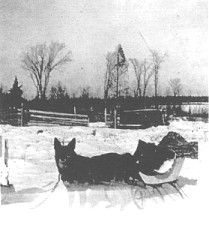 Another Camp Dog pulling a small sleigh |
I hope I have succeeded in clarifying the facts and have ended the confusion that was created as a result of the website created by these four uninformed individuals. Actually, this site has helped to provide us with the opportunity to discuss what sets our A.I.Dogs apart from other breeds and separates the pro-AKC types from the types of people we enjoy having as our family of happy owners.
We invite you to call for more information on the breed, and to contact a knowledgable owner/representative in your area, that is more than willing to share their own experience with their A.I.Dogs. Please visit the following websites www.indiandogs.com; www.iidoba.org or www.ipdba.k8.com
Kim La Flamme, Founder/Trustee
 1978 - Kim La Flamme and "Stars Shadow" R.# 2000, light silver/cream, Hare and Plains blood lines, Father of Dawning Moon |
 1985 - Kim's Daughter Alaisha La Flamme and A.I.Dog "Black Bear Dancer" R.# 2059 |
 1988 - Kim La Flamme and his chocolate pups " Choco" and "Choco - lote" R.# 2052 and # 2053 |
 Early 1970's -The Northern lines of Village Indian dogs used in the breeding program at that time. These old northern lines have mostly been lost now absorbed into the Alaskan Husky registry, being used for sled dog racing, mixed with various husky breeds |
(For those interested in learning more about the history of modern dog breeding, I would highly recommend Harriet Ritvo's ANIMAL ESTATE (Harvard University Press, 1987), which contains an excellent account of the formative years of stud books, pedigrees and shows, and a review of THE POLITICS OF DOGS by Mark Derr (March 1990 issue of Atlantic Monthly) a must for anyone who wants to understand the ins, outs, whys and how's of modern dog breeding. To learn about the history of the western Plains Indian lifestylesand their dogs; Dr. William Newcomb's INDIANS OF TEXAS (University of Taxes Press, 1961).- William Goetzmann's, THE WEST OF THE IMAGINATION (W.W.Norton and Co., 1986); THE DOG GAME, by Nigel Aubrey-Jones; Bill Pferd's DOGS OF THE AMERICAN INDIANS, or "The Canine Diversity Project" article;, "The Downside of Inbreeding, It's Time For A new Approach - by C.A. Sharp - www.canine-genetics.com or visit these websites for further information: Please visit the following websites www.indiandogs.com; www.iidoba.org or www.ipdba.k8.com. Or you may wait for my book on AMERICAN INDIAN DOGS, by Kim La Flamme and Anthropologist Pat Cummins, for a real experience in traditional Anglo misconceptions and stereotypes of nineteenth-century Amerindian life and dog breeding -- Kim LaFlamme)
This is a letter sent to Kim La Flamme by a cultural anthropologist to be put into the A.I.Dog Club newsletter years ago, before computers. This is in rebuttal to a letter that two A.I.Dog breeders, (at the time), had sent to all A.I.Dog owners and the Rare breed Dog Clubs. More recently they sent this letter to the new IPDBA registry, dog trainers, A.I.Dog breeders, owners and is now the hoax / warning site. - As you will see this anthropologist agreed with Mr. La Flamme's knowledge of genetics, breeding and old research findings from the Elders, as does the IPDBA, modern knowledgeable scientists/geneticists and almost all owners and breeders now.
" Kim please put this in your next A.I.Dog newsletter.:
Dear Ms_______,
I received your letter of May 6, concerning the status of the American
Indian Dog (and the A.I.Dog club). Since you requested professional
opinions, I would like to correct some misconceptions you seem to have
about the history of American Indian Dogs, the business of dog breeding
and the purpose of an Indian Dog Club. As a cultural anthropologist
specializing in the study of domesticated animals and their relationships
with human societies, I can tell you, for instance, that the morphological
"irregularities" you mentioned are both appropriate and necessary
to maintaining such a breed. And the concerns you express about uniformity
of appearance are not only unwarranted but could be detrimental to the
future of these dogs, since they were never bred by American Indians
under AKC-dictated criteria for fixing a "standard" of superficial
inherited traits, such as uniform coat color. Perhaps it would help
if I provided a little background on the traditional lifestyle of the
Plains tribes before and after the introduction of the horse, which
affected their ways of life more than any other element of Anglo culture.
Most of these Indians migrated seasonally from one location to another
in small bands composed of one or more extended family units. They rarely
met with fellow tribesmen, and spent time with other bands only once
a year, when they exchanged information, material goods, foodstuffs,
dogs and even people before parting once again to search for sustenance.
Before horses were incorporated into Plains culture , migratory routes
were smaller in size, which meant they were fairly isolated in a cultural
sense. When these foot-bound societies acquired the horse they experienced
a cultural revolution-- because they ultimately emerged with the greatest
freedom of movement of all North American Indians, which in turn allowed
them to take advantage of more natural resources, to meet more frequently
with fellow bands, and to establish contact with new tribes (both sedentary
and migratory). The point of this is to mention some of the variables
that have played a part in the evolution of the native domestication
canids, whose gene pools were constantly influenced by the infusion
of new blood from the dogs of other tribes and/or regions, not to mention
the periodic and often deliberate introduction of "wild genes"
from coyotes and incoming migrating groups. Just as the Indians exchanged
material goods and information when they encountered one another, they
also traded dogs and horses. A migratory way of life calls for endurance,
intelligence, sound temperament and versatility, all of which were the
breeding priorities of native Americans when it came to both dogs and
horses. A preoccupation with the cosmetic features we see among dog
breeders today would have been considered foolhardy by "traditional"
Native Americans , if not insane.
Mendelian genetic theories were little heard of before the second half of the nineteenth century, and only then by a few educated dog breeders in Europe and America, who were more concerned with the socioeconomic status to be gleaned from possessing an animal that conformed to the "beauty" trends of the day. And these Victorian-era priorities served as the model for most if not all modern breed standards, including those of AKC-sanctioned animals. Some dog owners may find it difficult to understand how such a diverse group of Indian Dogs could be defined as a breed, especially since other breeds are identified by how "little" physical variation they show from one individual to another. But the differences you call "irregularities" should not be seen as flaws, since the history of the American Plains Indian tribes are inseparable from the history of the Native Dog, and therefore must be taken into account in current breeding programs. To force these dogs into the "standard" mold after only a few decades is to fail to take into account the realities of how they were originally used and bred.
Some A.I.Dog owners may be confused by the assertion that they may possess an "ultimate mutt" instead of a true Indian Dog may want to do some homework. Is Kim La Flamme's plains-type American Indian Dog a true breed? Certainly, though perhaps not in a way of those who perceive a "breed" to be carbon copies of an arbitrary human construct. Enthusiasts who feel more comfortable dealing with such clones probably should stick with pedigreed poodles or Pekingese's, and leave the task and fun of rediscovering and protecting a crucial aspect of American Indian experience to those who understand and accept the origins of Native American Dogs. Much remains unanswered about the relationship between native dogs and their historic American Indian patrons, so it is crucial that the elements of genetic variability be preserved as vital clues to the multiple origins of the breed, NOT to be discounted as liabilities.
It's possible
that some revision of the A.I.Dog Club may be warranted, but personal
insults, back-biting and thinly-veiled threats over imagined misrepresentation
of the Indian Dog are not necessary. After all the trials and near-disasters
this animal has experienced in the past two hundred years, it would
be a tragedy to lose it now in a whirlwind of ignorance, warring egos
and preoccupation with superficial traits.
Sincerely,...........Cultural Anthropology and Museology,________cc;
to Kim La Flamme and A.I.Dog Club members
![]()
Some Further
Information...
|
I am American Indian and have worked with many Native organizations and Elders focused on the protection of Sacred Sites, Native Rights and the return of Ancestral human remains and objects. The results of this work included the restoration of native flora and fauna to numerous sites. For over 20 years I have studied with archaeologists, anthropologists, ethnographers, biologists and ethno botanists in central and Southern America and Canada. I have worked at a wildlife refuge for several years where we rehabilitate native wildlife for release back into the wild. My experience also includes working with large cats around the world. Our expert care for these animals comes from veterinarians that teach at universities and as well as health, have a good knowledge of genetics too. I live with my family on 50 acres of land formally designated as a sanctuary where we grow endangered native plants; plants used for medicine, food, ceremony and fiber and dyes for traditional basket weaving. The land is also a release site for animals that have been rehabilitated. Many scientists, scholars, wildlife experts and veterinarians frequent the sanctuary. There are on site classes enjoyed by Native and non-native people. Many Elders in the Indian communities teach and tell stories. Many stories are told of our indigenous dogs. Our American Indian Dogs that make the sanctuary their home have been a focal point for all that come here. They have a symbiotic relationship here with both animals and people. We are all grateful and honored to have them still here with us. Dogs have an ancient history all there own. The modern breed registries and most breeders have conveniently forgotten the varied genetics all dog breeds have and how important paying close attention to genetics can be for the future of any animal. Many people unhappy with the multitude of health and emotional problems related to “pure” AKC type or “exotic” breeds are now seeking out a healthy dog breed; (The American Indian). Pervasive in western thinking is that all life is homogenous, the same, sameness is a virtue. They need to isolate and label the AKC types in order to understand them and put them in categories. Veterinarian’s opinions vary on treatment and care, trainers on discipline and training. All these same political opinions have even involved our American Indian Dogs. Beyond scientific theory, doctors and technology (where scientists must remain detached from there subject matter) ; exists the wisdom of the Elders in the American Indian communities throughout North and South America. Indian people are taught and do this naturally; to participate, interact and experience life and their surroundings, regardless of profession. When the Elders speak of harmony and balance it is energy that radiates throughout the Universe. It is a movement that is always evolving, shifting and always changing. Many tribal people have moved to new locations environments, intermarried and exchanged stories and knowledge, medicine and cultural traditions. Some of this knowledge and traditions have survived the worst of adversity. Elders still continue to pass on this knowledge to those honorable enough to receive this precious and guarded wisdom. Kim La Flamme has been accountable not only for his breeding practices but also to the Elders, who have guided him with their knowledge. Kim La Flamme has chosen to share his life long work knowledge and his dogs, an achievement accomplished with dignity and dedication to preserving our American Indian Dogs. What
I have learned from scientific experts is that relatively little
research has been done on our native dogs. These studies are in
their infancy. To the lay person it might appear that substantial
studies have been done. The scientific theories on this subject
by numerous disciplines, not only vary; but are very contradictory
at best. Many studies have failed to even answer some very basic
questions. Evolutionary biologists have bitterly disputed what
constitutes a “Species”. Some of the latest research
suggests the domestication of dogs was an event that happened
several times in deferent parts of the world. These domesticated
dogs may have bred again with wild canines and were then again
domesticated. There is NOT a collective view or opinion from “scientists”
or “veterinarians” on American Indian Dogs. . Diversity
among the human species is hard enough of a concept for many people
to accept or respect let alone the genetic variation of dogs.
I hope the irretrievable loss and lack of respect of these dogs
in the past will not continue in the present fueled only by ignorance
and misunderstandings. Different world views colliding define
the conflict surrounding the American Indian Dogs. One very important
thing to remember, to quote Kim La Flamme ; “The only thing
that matters is that the American Indian Dog breed is simply the
closest thing we have left on this planet of our old Indian Dogs,
and the healthiest dog breed, both mentally and physically, and
if we can maintain control of our own breed, it will remain that
way, plane and simple.” |
 2002 - one of the most recent northern lines used in the breeding program, found in Canada, Hare and Village Indian dog blood lines |
 1991 - new owner picking up her A.I.Dog pup |
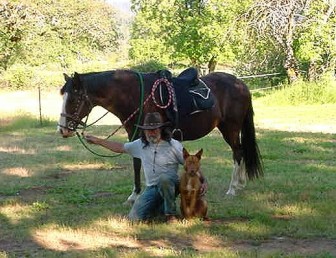 From the old to the new - Mouseman, the newest 'stud dog' in a long line of Indian Dogs, shown here with Kim La Flamme and Kilki, one of Kim's Peruvian Paso Horses. |
|
![]()
Owner's Opinions
![]() Owner's Opinions
Owner's Opinions
![]() Page
One
Page
One ![]() Page Two
Page Two ![]() Page Three
Page Three ![]() Page Four
Page Four ![]() Page Five
Page Five
![]() Page Six
Page Six ![]() Page Seven
Page Seven ![]() Page Eight
Page Eight ![]() Page Nine
Page Nine ![]() Page Ten
Page Ten
![]() Page Eleven
Page Eleven ![]() Home
Home
© All graphics and
photos copyrighted
and property of Song Dog Kennels.